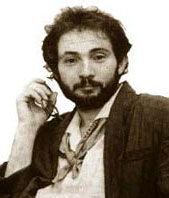Around Guelman 
The GIF.RU project appears to be not just an information resource but an element of a new cultural machine. It presupposes that enthusiasm for the cultural building will dominate here, in contrast to a critic’s distant view. It also presumes a clearly formulated position towards the subject itself, i.e. Art of Russia. We are not interested in regional art; we are interested in the world’s art phenomenon, which can be found on the territory of Russia. We are going to provide consistent support to the occurrences of the unified cultural space, wherever they might appear, but we’re absolutely indifferent to local ones, even though they may seem successful.
The GIF.RU project is our optimistic manifesto and our "protocol of intentions." Despite the wretched cultural policy, Russian contemporary art is developing. Regardless of isolation trends in society, Russian artists and literary men speak the international language of modern culture. The world’s tendencies, however, reflect in art all over Russia, from Moscow and Petersburg through Ekaterinburg and Kaliningrad. Everything that could happen owing to efforts of individuals did happen. The only thing missing was a cultural policy. Without such a policy, it is impossible for Russian art to influence the world’s art process.
In every kind of Russian consciousness such as the ruling-class consciousness, mass consciousness or the consciousness of intelligentsia art of the future has been replaced by art of the past. 30,70 or 150 years ago. Due to the crisis of the world’s culture and a habit to favoritism, which is easily gained by local authorities, the fact of the replacement has put Russian contemporary art in some kind of a queer recess. The GIF.RU project is going to form a different picture of Russian art not only on Net and not only in Russia.
There is, apart from anything else, a huge gap between the capital and the provincial contexts in Russia. One of GIF.RU’s main purposes is correlate them. To get over the gap means to carry out a cultural policy. In fact, actual art of the center today is not connected to the provinces. Meanwhile there are talented and mature artists over there, which are being slighted in the local context. GIF.RU’s task is to find, to choose, to urge to a successful career and thus influence cultural liability of local cultural institutes (museums, officials, educational institutions). The story of Cinderella is a Russian version of the American dream. Her family and her local context considered her lazy, ugly, stupid and worthless. She needed someone to come from without (a kind of prince) who would carry a new criterion system in order to find, to value and elevate.
From Creative Work to ArtOver the past decade a huge cultural machine, which functioned in the Soviet Union, shrank. We have inherited more than two thousand art museums. We have unions of artists, art schools, that is, we seem to have all the necessary details for constructing a cultural machine. However, in order to make a car from details one must know how it functions, i.e. its working principles. There is not such understanding. Neither had it the ex-Ministry of culture, nor the present one, not to mention Moscow’s authorities.
A cultural mechanism is based on several quite simple laws. In order to master them we have to overcome the soviet cliche "art and creative work", which means the assimilation of creative work to art. There are a great number of creative personalities, especially in Russia. Hundreds of thousands. All of them are eager, prolific and need to express themselves somehow. In comparison with these numbers the circle of art occurrences, which undoubtedly belong to our art history, is rather limited. Russian fine art of the 19th and 20th centuries is, at best, not more than a hundred names.
The main task of the cultural machine is to use creative potential as much as possible for the forming of the national art. The machine has to execute a few functions. The first function is to orientate. A creative person defines his position, seeks high standards. Art gives him samples, and the cultural machine should carry these samples to him. The second function is selection and ascent. The first function is an educational one, the second one play the role of a filter.
The cultural machine works in a vertical way: from creative work to art, from regions to the center. People rush to the center, cultural samples return to the provinces. Internet allows abolishing distances, and therefore GIF.RU will be a filter equidistant from art phenomena in Moscow and Vladivostok.
From Past to FutureFinally, the cultural machine must provide the link between the past and the future. The art of the 60s (whatever we think of it) is going away, becoming a part of history. There isn’t continuity between the art of the 60s and so called actual art. This historical gap is considered a catastrophe, a rupture of out-look by several generations. Russian cultural policy should be directed to smoothing away junctions between the two historical spaces and to the renewal of the connection between generations.
Therefore, the three main tasks of the cultural policy are: to preserve the past, to guarantee the future possibilities of development and provide the connection between them. Without trying to build interaction between the past and the future, without understanding the way the past influences the future, Moscow’s pathos turns out to be just a pile of estimates. A construction works estimate, a gas-main estimate, etc. Some of these works have been done. However, do we have the temple? No, we have not, because we have not got the comprehension how to construct cultural links.
Today the replacement of paradigms in art happens more often than biological changes of generations. Thus, we have phenomenon of "cohabitation" of the representatives of different epochs’ at the same galleries, museums, magazines, i.e. in one cultural space. Cultural substance becomes very quaint, easy to divide into layers of autonomous groups, every one of which has its own parameters of evaluation, its own language, its own sigh systems. One of the tasks of scientific institutes is to bring these concepts together. Being independent observers, they have to be engaged in "sewing together", i.e. in forming a mutual communication space. GIF.RU is going to grant its space for researchers, critics, art historians, and theoretics. It will stimulate the appearance of adequate descriptions of art situations.
From Arbitrariness to the Division of Spheres of InfluenceA research institute as an institute in art is being slighted - in Russia today our authorities build their relations with art on the principle of favoritism. These institutes seem to be useless since the head artist or the president or a mayor chooses the head musician. No politician all over the world would dare to directly finance artists. It accomplishes only through mediation of special cultural institutions. Our politicians, by doing it directly, bring to naught importance of cultural mediators. The best example is Lysenko, a "great" scientist under Stalin. All the science was rejected only because Stalin had decided that Lysenko was a great scientist. Stalin died, so did Lysenko, science grew up afresh, but what an enormous loss in had suffered! Favoritism is a monstrous illness of our authorities: not only because it is injustice, not only because the present mayor has a bad taste (the next one might have better one). The point is that favoritism crosses out institutes, which are very important for the forming of a new language. This language ought to sew together the past and the future. I’ve gone into politics not because I wanted to do it, but because while Luzhkov is engaged in culture, I’m engaged in politics. I’m doing it in order to tell to him: it’s an unnatural situation.
Therefore, GIF.RU will not avoid politics and politicians; on the contrary, it’s going to promote a deserved, adequate and natural inclusion of Russian art into Russian society.
Irresponsibility of our authorities reveals itself in the fact that they don’t admit their mistakes. They don’t realize that it might lead to destructive consequences in the cultural mechanism. A complicated system of critique is being built, which is a very difficult thing to do in contemporary art. This system is based on a number of structures such as Institute of culture, the Tretyakov gallery, Russian State Humanitarian University, the Center of Modern Art. A reputation system and conceptions are being formed... Suddenly the mayor Luzhkov favors the "great" artist Shilov with a premise, and it becomes clear that everything listed above is unnecessary. The most important thing is to be liked by Luzhkov. That is called the slighting of real art. I’m sure that the mayor of Berlin is as bad at art as Luzhkov. However, we know nothing about it. Expect that we’ll visit his bedroom one day and notice a bad picture on the wall. Tastes of Berlin’s authorities don’t affect its cultural life.
Political elite has the only way to be formed, i.e. election, and the only way of rotation. Cultural elite also has it: consensus, critique... Hierarchy in art is a less monosemantic idea than in sports or in politics, but it exists. The cultural mechanism will function all right if these elites start cooperating equally and acknowledge each other.
Internet gives a marvelous possibility to describe a subject of cultural policy, to discuss its strategy and display the main participants of the process that is going on outside the state machine. I might be accused of being pathetic but I’m sure that the GIF.RU project will play exactly this role.























